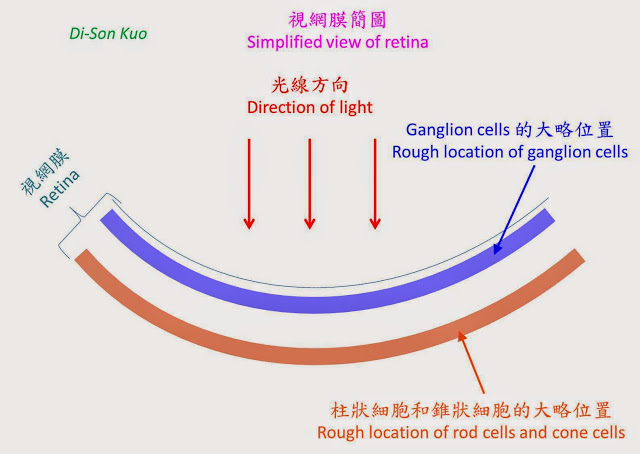陶醉於朝霞暮靄,心悸於晝夜飛逝。
迪生@2016
我們體內有幾種週期性的震盪器,其中最重要的一種,是主管心跳的震盪器。這種震盪器主要有三套:統御階層最高的那一套,集中形成一個節點,位在心臟的上緣、右心房頂,靠近左心房處,被稱為
「SA Node」。而階層次高的那一套,也是集中形成一個節點,位於右心室的底部,也是靠近左心房處,被稱為 「AV Node」。當SA Node發出的脈衝信號因故而無法往下傳時,AV Node就會自動出來代理。 階層最低的那一套,則散處在兩個心室之間被稱為
「Bundle of His」 的脈衝傳導通道上。
我們體內次重要的一種週期性的震盪器,則是所謂的「生理時鐘」了。在國際的醫學專有名詞裡,它們被稱為「Circadian Clock」。「Circadian」是《「Circa」+「Dia」》的形容詞。前者是拉丁文裡「大約」的意思,而後者則是拉丁文裡「一天」的意思,所以它的直接含意,是「週期大約是一天的時鐘」。「生理時鐘」一詞,並不是它的直接翻譯。我們體內的好幾個器官,都有自己的生理時鐘。不過在正常情況之下,它們都會接受其中一個主帥的領導統御。而這個主帥生理時鐘,則位在我們大腦的底部,在兩條視神經左右交會及交錯點的上方。在生理解剖學裡「交錯」叫做「Chiasma」,「上方」則常用「Supra」。而一群職司相近的神經細胞集結在一起,則常被稱為「Nucleus」。所以這個主帥生理時鐘所在的神經細胞群,就被稱做「Suprachiasmatic
Nucleus」,簡稱作「SCN」。
生理時鐘和前述的心跳的震盪器,雖然都是震盪器,可是有幾個大的差異。其中最明顯,但不是最基礎性的差異,是在於它們的震盪週期。SA Node 的自然週期,大致是介於每分鐘的 1/60至 1/100之間。 AV Node 的自然週期較長,而「Bundle
of His」的自然週期則更長,大致是介於每分鐘的 1/30至 1/50之間。 而大部分生理時鐘的自然週期,都在24 小時左右。譬如說:在沒有外來訊息的影響之下,人類的 SCN 的自然週期平均大約是24 小時15分鐘。而人體從環境得到的訊息,會把週期拉到24
小時。
這兩種震盪器比較基礎性的差異,是在於它們產生震盪的機制,和在細胞內發生震盪的地區。這裡有一個動物細胞的結構示意圖,裡面有多種不同的器官。但是和我們現在的主題密切相關的,只有細胞膜、細胞核、和介於兩者之間的細胞質(cytoplasm)。
主管心跳的震盪器,其震盪是發生在細胞膜的內部與外部之間。而參與震盪的物質,則是像納、鉀、鈣這樣的基本離子。這些帶電的離子在細胞膜的內部與外部之間的相對數量,會影響細胞膜的電位。而在像 SA Node這些地方的細胞的細胞膜電位,則會顯著改變那些基本離子進出細胞膜的穿透率。在這樣的回饋機制之下,就產生了離子濃度的震盪。而這種震盪所衍生出來的電位脈衝,則推動了你、我賴以為生的心跳。
生理時鐘的震盪器則大不相同,其震盪是發生在細胞核與細胞質之間。而參與震盪的物質,則是複雜很多的蛋白質分子。這些蛋白質分子,是在細胞核由 DNA 製造出來的。而不同生物的生理時鐘所利用的蛋白質結構和種類數目,也略有不同。生物越高等,參與的生化反應也越複雜。在人體內生理時鐘的細胞裡,細胞核裡面的
DNA 會製造出兩組和生理時鐘有關的蛋白質。這兩組分別是(PER1、PER2、PER3)和 (CRY1、CRY2)。而這個製造過程,需要另外兩種蛋白質 CLOCK 和 BMAL1 結合而成的雙體(dimer)來催化,才會有效率。那兩組蛋白質被製造出來之後,會被運輸到細胞核外的細胞質裡。等到細胞質裡的那兩組蛋白質濃度到達一個定值時,它們會交叉結合成複雜的大分子,同時進入細胞核裡去抑制
(CLOCK:BMAL1)雙體的功能。於是那兩組蛋白質的濃度,會開始降低,然後(CLOCK:BMAL1)雙體又會逐漸恢復功能,幫助 DNA 製造那兩組蛋白質。這個蛋白質濃渡的震盪過程,就這樣地以大約 24小時的週期周而復始著。
SCN 會將這個週期的狀況,輸出到大腦的其他部位,特別是松果體(Pineal Gland),來控制全身的生理狀況。同時,SCN
也會接受身體其他部位送來的訊息,來調節它自己的狀態。其中最重要的影響訊息,是來自就在它旁邊的視神經。 我們眼球的視網膜裡,有一些會感光、但是不負責成像的神經細胞,被稱為「Intrinsically
Photosensitive Retinal Ganglion Cells」。它們會把自己受光的狀態,傳送到
SCN 去,成為 SCN 調節狀態的最重要外來影響。我在另外一篇部落格文章「調時差」裡面,曾經向大家介紹過它們。 http://dison-kuo.blogspot.com/2013/12/blog-post_8239.html
SCN
這個生理時鐘,對我們相當重要。它不僅調節我們體內重要器官的狀態,讓它們適合應付當時的環境時間,以便從事進食及其他活動,它也對睡眠及蘇醒有重要的影響。我會在其他文章當中、和大家分享「睡眠」這個有趣的課題。
A brief description in English:
In our body, there are several
systems of biological oscillators. The
utmost important among them is the system responsible for cardiac rhythm. There are three components in this
system. At the top of the hierarchy is
the SA node, situated near the apex of right atrium of the heart, close to the
septum between two atria. One level down
the hierarchy is the AV node, located at the bottom of right atrium, also close
to the septum. If for some reason the
signal from SA node cannot travel down the heart, AV node will automatically
take over. On the bottom of the hierarchy
are a group of cells scattered along the electrical conduction pathway in the
middle, the “Bundle of His”.
The second important biological
oscillator system in our body are the “Circadian Clocks”. Several organs in our body have their own
circadian clock. Nonetheless, under
normal condition they are all subject to the command of a central circadian
clock, which is the “Surpachiasmic Nucleus” located near the bottom of
Hypothalamus in the brain, just above the chiasma of the left and right optical
nerves.
Although both cardiac pacemakers and
circadian clocks are both biological oscillator, there are major difference between
them. The most apparent difference, but
not the most fundamental difference, is in their oscillation periods. Among cardia oscillators, SA node typically
has a period between 1/100 to 1/60 of a minute.
AV node has a moderately longer period, and The Bundle of His has the
longest period, ranging from 1/50 to 1/30 of a minute. In contrast, most of circadian clocks have
period near 24 hrs. For example, among
humans SCN has an average period of 24 hrs and 15 minutes. However, the most fundamental difference
between cardia pacemakers and circadian clocks is in their oscillating mechanism
and the sites where oscillation occurs.
Attached here is an annotated schematic
of an animal cell. There are several different sort of organs in the cell. But the only organs pertinent to our current
theme are only cell membrane, nucleus, and cytoplasm between the two.
In the case of cardiac pacemakers,
the oscillation occurs between the cell membrane, and the chemicals involved are
the basic ions such as sodium ion, potassium ion, and calcium ion. The relative abundance of these ions inside
and outside the cell membrane determines the membrane’s electrical
potential. On the other hand, the
membrane’s electrical potential affects its permeability for these 3 ions. Such a feedback mechanism leads to the
oscillation of ionic concentration, which generate electrical pulses that drive
our heartbeats.
In contrast, the biological oscillation
of circadian clocks occurs inside and outside the cell nucleus. Although there are similarity among different
species in the oscillation mechanism, the more evolutionary advanced the
species, the more complex the biochemistry is.
For example, inside the nucleus of human circadian clock cells, DNA manufactures
two sets of special proteins that are relevant to circadian rhythm. One set includes PER1, PER2, and PER3, and
another set include CRY1 and CRY2. This
manufacturing process needs the catalytic help from a dimer formed by two other
proteins, CLOCK and BMAL1. Once PERs and
CRYs are produced, they got transported out of the nucleus to cytoplasm. When the concentration of PERs and CRYs reach
certain level, they will crossly form a large complex and move back inside the
nucleus to suppress the catalytic function of (CLOCK:BMAL1) dimer there, hence
thwarts the production of PERs and CRYs.
Consequently, the level of PERs and CRYs falls and (CLOCK:BMAL1) dimer gradually
resume their catalytic function of aiding DNA to produce PERs and CRYs. Such a process repeats itself with a period around
24 hrs.
SCN will broadcast the status of
circadian clock within it to various parts of the central nerve system,
especially the Pineal Gland. In the
meanwhile, it also receives signals from various parts of the body to adjust
the status of its clock. The most
important signal comes from the optical nerves next to it. In the retina of our eyes, there is a type of
cell that is sensitive to visible light, yet does not participate in image
formation. They are call “Intrinsically
Photosensitive Retinal Ganglion Cells”, and projects their output to SCN. I have touched upon them in an earlier blog
article titled “Adjusting Jet Lag.” http://dison-kuo.blogspot.com/2013/12/blog-post_8239.html
The circadian clock at SCN is highly
crucial to our health. Its signal hels
various organs in our body to match the timing of the environment and prepares
them for timely activities such as eating and hunting/gathering/farming. Furthermore, SCN plays an important role in
regulating our sleep and wakefulness. I
will share with you the interesting subject of “Sleep” in a separate block article.







No comments:
Post a Comment